It’s no secret that learning a musical instrument can be a challenging task. Some instruments are notoriously difficult to master and can take years of practice to learn properly. While many online guides cover easy instruments to learn, we want to shine a light on those most difficult either for those who like a challenge or those who want to steer clear at all costs.
Violin
Perhaps to nobody’s surprise, the violin is widely considered to be one of the most difficult instruments to learn. The high level of coordination required to play the violin is what puts many people off as it takes years of practice to develop the necessary skills. The good news is that once you do master the violin, you’ll be rewarded with one of the most versatile and rewarding instruments out there.
What makes the violin so difficult? As mentioned, the main thing that makes the violin so difficult is the level of coordination required to play it. While your right arm (traditionally) holds the bow, your left arm must simultaneously hold the instrument and position the fingers on the strings.
Oboe
Even if you couldn’t point an oboe out in a line-up, you will have almost certainly heard this instrument before. The oboe has a distinctive, reedy sound which is often used in film scores to represent eeriness or sadness (think of the 1978 film Halloween, for example).
The oboe is notoriously difficult to play, due in large part to its double-reed mechanism. This means that, unlike other wind instruments which use a single reed (such as the clarinet), the oboe uses two pieces of cane that vibrate against each other to create sound.
Not only is it difficult to learn how to make a good sound on the oboe, but it is also difficult to keep a good sound going. The reeds are sensitive to temperature and humidity, meaning that they can go out of tune very easily.
Piano
For many years, the piano has often been cited as one of the most difficult instruments to learn, and it is certainly true that it takes a lot of practice to become proficient. However, the piano is also a very rewarding instrument to learn, and once you have mastered it you will be able to play a wide range of music. Whether you want to play along with music or impress people with your solo playing, the piano is a great choice.
French Horn
Next, we find an instrument in the brass family – the french horn. The reason the french horn is so difficult is that it requires a lot of control and accuracy from the player. For one thing, you need to be able to produce a clear, pure sound without any mistakes. What’s more, you need to be able to play in tune with the rest of the band. There are a lot of notes on the french horn, and it can be difficult to keep track of them all.
Tuba
As another brass instrument, the tuba is also quite difficult to play. In fact, it’s often said that the tuba is one of the most difficult instruments to learn. Much like the French horn, the tuba requires a lot of control from the player. The second the player loses control, the sound becomes fuzzy and difficult to listen to. In addition, the tuba is a very large instrument, which can make it difficult to carry around and hold.

